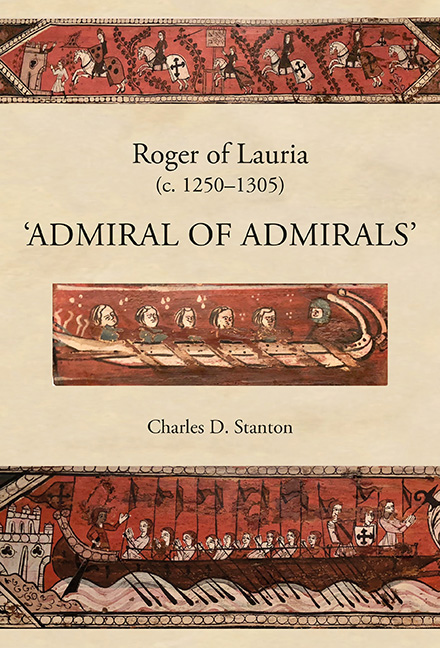Book contents
- Frontmatter
- Dedication
- Contents
- List of Illustrations
- Prologue
- 1 Battle of Benevento (26 February 1266)
- 2 A Calabrian Exile in the Court of Aragon (1262–1282)
- 3 Battle of Tagliacozzo (23 August 1268)
- 4 Aragonese Expansion (1229–1282)
- 5 Angevin Consolidation and Aggrandizement (1268–1282)
- 6 Revolt of the Vespers (30 March 1282)
- 7 Aragonese Intervention (August–October 1282)
- 8 Stalemate (November 1282–March 1283)
- 9 Admiral of Aragon (20 April 1283)
- 10 The Opposing Fleets (1282–1302)
- 11 Battle of Malta (8 June 1283)
- 12 Anjou's Dreams of Empire Dashed (June–November 1284)
- 13 France's Crusade Against Aragon (May–November 1285)
- 14 Battle of the Counts (23 June 1287)
- 15 Truces and Treaties (June 1287–November 1291)
- 16 Raid on Romania (Summer 1292)
- 17 Switching Sides (December 1293–April 1297)
- 18 Aragon's Invasion of Sicily at Anjou's Bidding (1298/1299)
- 19 Lauria's Last Great Campaign (Summer 1299–Spring 1300)
- 20 Endgame (Spring 1301–Summer 1302)
- Epilogue
- Bibliography
- Index
10 - The Opposing Fleets (1282–1302)
Published online by Cambridge University Press: 24 October 2019
- Frontmatter
- Dedication
- Contents
- List of Illustrations
- Prologue
- 1 Battle of Benevento (26 February 1266)
- 2 A Calabrian Exile in the Court of Aragon (1262–1282)
- 3 Battle of Tagliacozzo (23 August 1268)
- 4 Aragonese Expansion (1229–1282)
- 5 Angevin Consolidation and Aggrandizement (1268–1282)
- 6 Revolt of the Vespers (30 March 1282)
- 7 Aragonese Intervention (August–October 1282)
- 8 Stalemate (November 1282–March 1283)
- 9 Admiral of Aragon (20 April 1283)
- 10 The Opposing Fleets (1282–1302)
- 11 Battle of Malta (8 June 1283)
- 12 Anjou's Dreams of Empire Dashed (June–November 1284)
- 13 France's Crusade Against Aragon (May–November 1285)
- 14 Battle of the Counts (23 June 1287)
- 15 Truces and Treaties (June 1287–November 1291)
- 16 Raid on Romania (Summer 1292)
- 17 Switching Sides (December 1293–April 1297)
- 18 Aragon's Invasion of Sicily at Anjou's Bidding (1298/1299)
- 19 Lauria's Last Great Campaign (Summer 1299–Spring 1300)
- 20 Endgame (Spring 1301–Summer 1302)
- Epilogue
- Bibliography
- Index
Summary
THE MAINSTAY OF THE MEDIEVAL battle fleet was the galley. It had changed little since classical times. It was long and narrow with a length-to-width ratio as high as 10:1, which – along with a minimal keel and a shallow draft – enabled it to cut through the water at great speed relative to other vessels of the era. Oars provided the primary means of propulsion, enabling the craft to cruise and manoeuvre independent of the wind when necessary. One or two sails were generally available to take advantage of favourable meteorological conditions, while sidemounted steering oars supplied directional control. It was the most complex, labour-intensive weapon of war of the Middle Ages. Those commanders who treated it as simply an extension of the battlefield, characterized by hand-to-hand combat, were doomed to eventually fail, while those who grasped its idiosyncrasies and unique capabilities were destined to ultimately prevail. The Angevin admirals fell into the former category, while Roger of Lauria resided in the latter.
The prototype of the medieval war galley was the Byzantine dromōn (Fig. 6). Believed to have evolved from the liburnian (a light warship of the late Roman period, patterned after the pirate ships of the Liburni people of Illyria), it dominated maritime warfare in the Mediterranean from the end of the fifth century to the beginning of the twelfth. Measuring roughly 31.25 metres (102 ft 6 in) long by about 4.46 metres (14 ft 8 in) of beam, the dromōn was a fully decked, bireme galley (two files of oarsmen per side) that carried a crew complement of 108 rowers along with around 35 marines and officers. Auxiliary power was provided by two lateen sails on a foremast and a main mast, while steering was supplied by two quarter-rudders mounted on either side of the stern. A chain-secured spur (for smashing the oars of an enemy ship and to aid in boarding) projected from the prow, replacing the embolos or waterline ram of antiquity. The marines manned a forecastle (xylokastron) on the bow, which housed a siphon for spewing Greek fire, as well as a pair of castles (kastelloma) amidships on either side of the main mast, which served as platforms for ballistae or other projectile-launching devices.
- Type
- Chapter
- Information
- Roger of Lauria (c.1250–1305)‘Admiral of Admirals’, pp. 126 - 146Publisher: Boydell & BrewerPrint publication year: 2019

